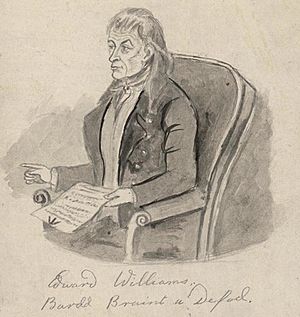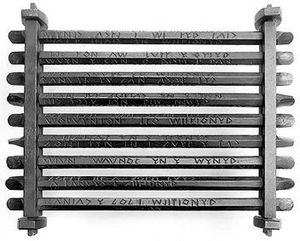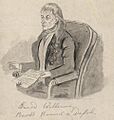Iolo Morganwg facts for kids
Quick facts for kids
Iolo Morganwg
|
|
|---|---|

Drawing of Iolo Morganwg (c. 1800) by an unknown artist, in the National Library of Wales
|
|
| Born | Edward Williams 10 March 1747 Pen Onn, Glamorgan, Wales |
| Died | 18 December 1826 (aged 79) |
| Occupation | Stonemason, poet and collector |
| Language | Welsh |
| Nationality | Welsh |
Edward Williams, better known by his bardic name Iolo Morganwg, was an important Welsh poet and collector. He lived from March 10, 1747, to December 18, 1826.
Iolo was seen as an expert on old Welsh writings. However, after he died, people discovered that he had created some "ancient" texts himself. These included parts of the Welsh Triads, which were supposed to be very old Welsh poems.
Even with this discovery, Iolo had a big impact on Welsh culture. He helped start the Gorsedd, a special group for Welsh poets and bards. His ideas, even those in his made-up texts, also influenced early neo-Druidism, a modern form of the ancient Druid religion. His bardic name, Iolo Morganwg, means "Iolo of Glamorgan" in Welsh.
Contents
Early Life and Interests
Edward Williams was born in Pen Onn, a place near Llancarfan in Glamorgan, Wales. He grew up in the village of Flemingston. Like his father, he became a stonemason, working with stone.
In Glamorgan, Iolo became very interested in collecting old handwritten books, called manuscripts. He also learned to write Welsh poetry from local poets. In 1773, he moved to London. There, he joined the Welsh literary community and became part of groups like the Gwyneddigion Society.
He returned to Wales in 1777, where he got married. His son, Taliesin, was named after an ancient Welsh bard. Taliesin later collected his father's many writings. Some of these were published as the Iolo Manuscripts in 1848.
His Writings and Ideas
From a young age, Iolo wanted to protect and keep alive the literary and cultural traditions of Wales. He created many manuscripts. He claimed these showed that ancient Druid traditions had survived through many challenges. These challenges included the Roman conquest, the spread of Christianity, and times when bards were treated badly.
Iolo's made-up writings presented a detailed, mystical way of thinking. He said this was a direct continuation of ancient Druid practices.
Early Works and the Gorsedd
Iolo first became well-known in 1789 for a collection of poems by Dafydd ap Gwilym, a 14th-century poet. This book included many poems by Dafydd that Iolo claimed to have found. These are now seen as Iolo's first forgeries.
His success led him back to London in 1791. There, he founded the Gorsedd, a community for Welsh bards. He held the first ceremony on June 21, 1792, at Primrose Hill. He organized this event using what he said were ancient Druid rituals. In 1794, he published some of his own poems, which were quite popular. This collection, Poems, Lyric and Pastoral, is considered his only truly original work.
Working on Welsh Literature
Iolo worked with other scholars on The Myvyrian Archaiology of Wales. This was a three-volume collection of medieval Welsh literature published between 1801 and 1807. This work used some of the manuscripts Iolo had collected. However, it also included some of his made-up material. This included a false history book and a book he said was written by Saint Cadoc.
The second volume of this collection contained the Welsh Triads. Iolo added a "third series" of made-up triads and changed some of the real ones.
Later Publications
After Iolo's death, some of his writings were put together by his son, Taliesin Williams, into The Iolo Manuscripts. Other scholars used Iolo's papers for their own work. For example, Lady Charlotte Guest used them when she translated the famous Welsh stories known as the Mabinogion.
More of Iolo's made-up works were published later in a text called Barddas. This work, published in 1862 and 1874, claimed to be a translation of old writings. It said it told the history of the Welsh bardic system from ancient times. While it doesn't contain real Druid knowledge, it fully explains the mystical ideas Iolo created.
Other works by Iolo include the "Druid's Prayer", which is still used by the Gorsedd and modern Druid groups. He also wrote a book on Welsh poetry rules called Cyfrinach Beirdd Ynys Prydain ("The Mystery of the Bards of the Isle of Britain"). This was published after he died in 1828. He also published a series of hymns in 1812.
Iolo's Philosophy
Iolo's way of thinking combined ideas from Christianity and the Arthurian legends. He was also influenced by the renewed interest in all things "Celtic" and the real bardic traditions that had survived in Wales.
Part of his goal was to show that South Wales, especially his home region of Glamorgan, had strong Welsh traditions. At the time, many people thought that only North Wales kept the purest Welsh traditions.
His writings explained a theory of "rings of existence." These rings moved outwards from Annwn (the Otherworld) through different stages to Gwynfyd (purity or Heaven).
Iolo also became a Unitarian by 1799. He was a key figure when a Unitarian Association was formed in South Wales in 1802. He wrote its rules and procedures, published in 1803.
The Bardic Alphabet
Iolo Morganwg created his own system of symbols, which he called Coelbren y Beirdd ("the Bardic Alphabet"). He claimed this was an ancient alphabet used by Druids. It had 20 main letters and 20 more for special sounds. These symbols were meant to be carved onto a wooden frame called a peithynen.
Discovering the Forgeries
Towards the end of the 1800s, a language expert named Sir John Morris-Jones helped show that Iolo had created some of his "ancient" texts. This led to Iolo being called a "charlatan," meaning someone who pretends to have special knowledge. Morris-Jones said that it would take a long time for Welsh history and literature to be free from Iolo's influence.
After the First World War, a scholar named Griffith John Williams (1892–1963) was the first to fully study Iolo's work. He looked at the original documents that Iolo's family had given to the National Library of Wales in 1917. Williams wanted to find out how much of Iolo's work was based on his imagination rather than facts. He confirmed that the poems Iolo said were by Dafydd ap Gwilym were indeed made up. His research helped people understand Iolo's true impact.
Some recent research suggests that a few of Iolo's claims might have been based on real oral traditions. For example, the story of Ieuan Gethin, a soldier in the Glyndwr revolt, might have some truth to it.
Iolo's Lasting Legacy
Iolo's made-up texts were so widely spread that, even in the 21st century, some of his changed versions of medieval Welsh texts are better known than the original ones.
A Welsh-language school in Cowbridge, Ysgol Iolo Morganwg, is named after him. Also, Gruff Rhys, the singer from the band Super Furry Animals, dedicated a song to Iolo on his 2014 album, American Interior.
Images for kids
See also
 In Spanish: Iolo Morganwg para niños
In Spanish: Iolo Morganwg para niños




